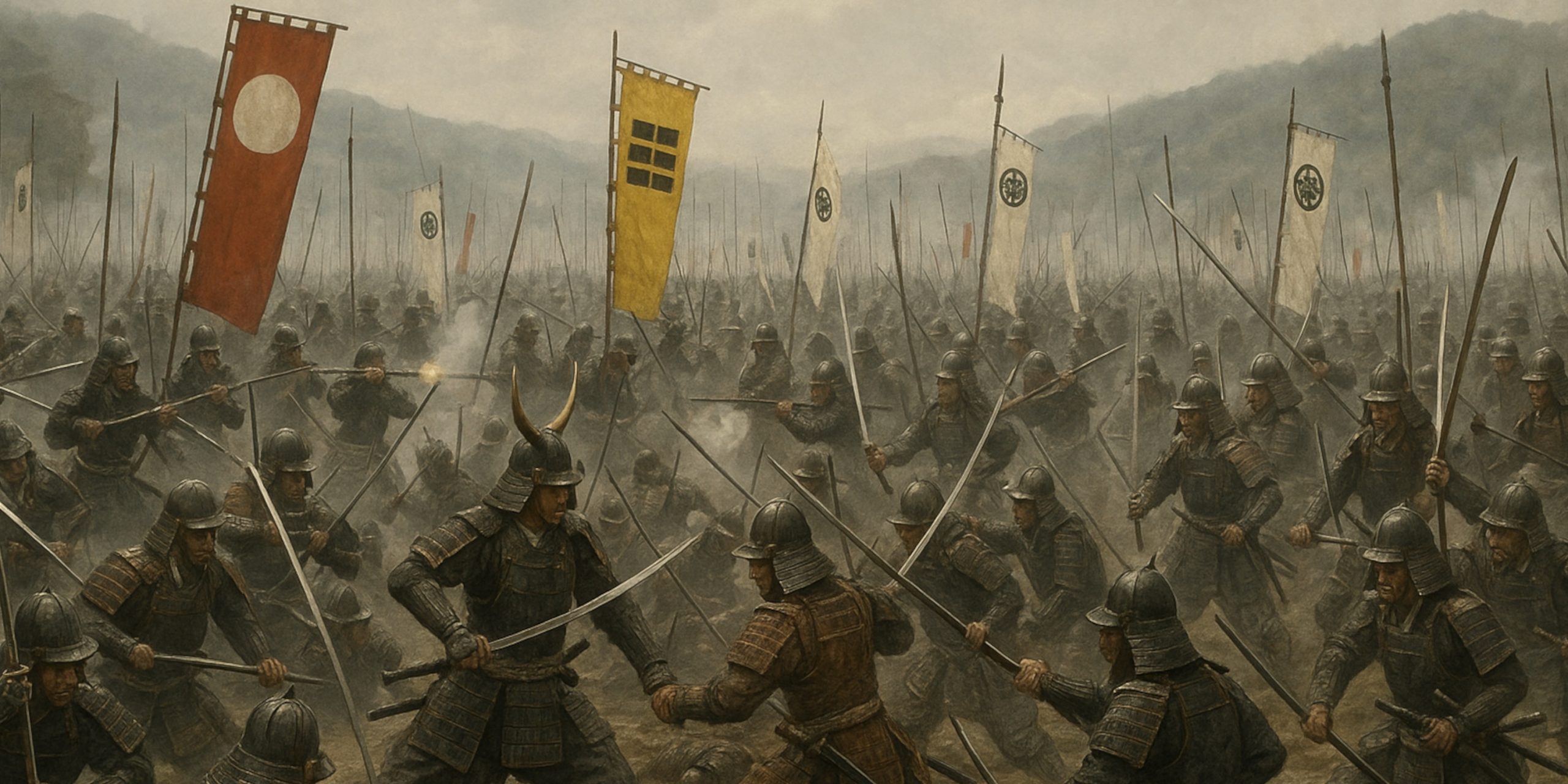
The Battle of Sekigahara, fought on 21 October 1600, was the most consequential conflict in Japanese history. It marked the end of the Sengoku (Warring States) period and set the foundation for the Tokugawa shogunate, which ruled for over 250 years. The battle was a struggle between two coalitions: the Eastern Army under Tokugawa Ieyasu and the Western Army led by Ishida Mitsunari.
Forces
| Army | Estimated Troops | Commander(s) | Key Allies |
|---|---|---|---|
| Eastern Army | 74,000+ | Tokugawa Ieyasu | Date Masamune, Honda Tadakatsu, Ii Naomasa |
| Western Army | 82,000+ | Ishida Mitsunari | Ukita Hideie, Shimazu Yoshihiro, Konishi Yukinaga |
Despite being outnumbered, Tokugawa’s superior coordination and political manoeuvring, especially with certain Western commanders, tipped the scales.
Leaders and Troop Composition
Eastern Army (Tokugawa Ieyasu)
- Tokugawa Ieyasu: Overall commander, politically shrewd, with strong logistical support
- Ii Naomasa: Aggressive vanguard leader, led elite red-armoured troops
- Honda Tadakatsu: Veteran general known for personal bravery
- Troop makeup:
- Ashigaru infantry
- Samurai cavalry
- Matchlock gunners (Teppō ashigaru)
- Mounted archers
Western Army (Ishida Mitsunari)
- Ishida Mitsunari: Court bureaucrat with limited battlefield experience
- Ukita Hideie: Commanded the centre, known for discipline
- Shimazu Yoshihiro: Respected commander but cautious in commitment
- Konishi Yukinaga: Experienced but hesitant Christian general
- Troop makeup:
- Spear ashigaru
- Heavy samurai cavalry
- Arquebusiers
- Naval detachments (not engaged directly at Sekigahara)
Arms and Armour
Weapons Used:
- Katana: Standard samurai sword, used in close combat
- Yari (spear): Dominant infantry weapon for its reach
- Naginata: Curved polearm used by both foot soldiers and women of samurai families
- Tanegashima (matchlock): Firearms introduced by the Portuguese, used widely by both sides
- Yumi (longbow): Retained use, especially by cavalry and elite guards
Armour:
- Tosei-gusoku: Modern-style plate and mail armour, layered for flexibility
- Kawari kabuto: Decorative helmets, often with antlers or horns for distinction
- Suneate and kote: Greaves and armoured sleeves, protecting limbs
- Armour varied by rank, with commanders often in ornate, identifiable designs
Battle Timeline

- Pre-dawn (21 October 1600): Thick fog delays visibility; both armies wait in position near Sekigahara village
- 08:00: Fog lifts. Tokugawa Ieyasu’s right and centre begin the attack
- Mid-morning: Ii Naomasa and Fukushima Masanori lead a charge that pushes into Ukita Hideie’s forces
- Midday: Kobayakawa Hideaki, nominally part of the Western Army, defects to Tokugawa by charging the Western flank
- Early Afternoon: More Western allies, including Wakisaka Yasuharu and Ogawa Suketada, switch sides
- Late Afternoon: The Western Army collapses; Ishida Mitsunari flees but is captured weeks later
Contemporary Quotes
- Tokugawa Ieyasu (reportedly): “After victory, tighten your helmet cord.”
A warning to stay vigilant even after success - Ii Naomasa, to his men: “Strike as if your lives depend on it—for they do.”
- Shimazu Yoshihiro, retreating from the battlefield: “Those who survive can fight again. Those who die become mere names.”
Archaeology and Battlefield Features
Modern archaeological digs in Sekigahara and the surrounding Mino Province have uncovered:
- Musket balls and fragments of matchlocks, confirming widespread firearm use
- Arrowheads, some of which are believed to have been fired from horseback
- Helm fragments bearing clan mon (crests), helping identify troop positions
- Remains of palisade structures and makeshift field fortifications
The battlefield is well-preserved, with markers indicating troop positions and shrines commemorating fallen commanders. A museum in Sekigahara town offers displays of weapons, battlefield maps, and relics.
Legacy
The battle concluded the Sengoku period and allowed Tokugawa Ieyasu to consolidate power. By 1603, he was named Shōgun by the Emperor, cementing the beginning of the Edo period. The Tokugawa clan would rule Japan in relative peace until the Meiji Restoration in 1868.
Sekigahara became a symbol of loyalty, betrayal, and the shifting allegiances that characterised samurai warfare. It is studied not only for its tactics but also for the political groundwork that preceded it.
Where to See Related Artefacts:
- Sekigahara Battlefield Museum (Gifu Prefecture): Interactive displays, battlefield maps, armour
- Tokyo National Museum: Original Tokugawa-era weapons and armour
- Nagoya Castle Museum: Displays of matchlocks and samurai crests from the Tokugawa holdings
- Osaka Castle Museum: Exhibits on the Western Army and Ishida Mitsunari’s life
Sekigahara was a turning point in Japan’s political history, shaped by ambition, deception, and the steel of thousands.
Watch the documentary:



